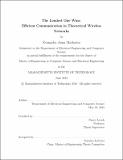| dc.contributor.advisor | Nancy Lynch. | en_US |
| dc.contributor.author | Markatou, Evangelia Anna | en_US |
| dc.contributor.other | Massachusetts Institute of Technology. Department of Electrical Engineering and Computer Science. | en_US |
| dc.date.accessioned | 2018-12-18T19:47:53Z | |
| dc.date.available | 2018-12-18T19:47:53Z | |
| dc.date.copyright | 2018 | en_US |
| dc.date.issued | 2018 | en_US |
| dc.identifier.uri | http://hdl.handle.net/1721.1/119737 | |
| dc.description | Thesis: M. Eng., Massachusetts Institute of Technology, Department of Electrical Engineering and Computer Science, 2018. | en_US |
| dc.description | This electronic version was submitted by the student author. The certified thesis is available in the Institute Archives and Special Collections. | en_US |
| dc.description | Cataloged from student-submitted PDF version of thesis. | en_US |
| dc.description | Includes bibliographical references (pages 68-70). | en_US |
| dc.description.abstract | In order to develop the most efficient algorithms for wireless networks, first one must understand their theoretical limitations. To this end, we study the leader election and broadcast problems in wireless networks, modeling them using the Signal-to- Interference-plus-Noise-Ratio (SINR) model. Our main result is an algorithm that solves the leader election problem in two communication rounds using power control, with high probability. Previously, it was known that [Omega](log n) rounds were sufficient and necessary when using uniform power, where n is the number of nodes in the network. We explore tradeoffs between communication complexity and power used, and show that to elect a leader in t rounds, a power range exp (n (1 [Theta] T) is sufficient and necessary. In addition, we present an efficient algorithm for the broadcast problem. Using power control, it is possible to achieve a broadcast algorithm that terminates successfully in 2n rounds, w.h.p.. | en_US |
| dc.description.statementofresponsibility | by Evangelia Anna Markatou. | en_US |
| dc.format.extent | 70 pages | en_US |
| dc.language.iso | eng | en_US |
| dc.publisher | Massachusetts Institute of Technology | en_US |
| dc.rights | MIT theses are protected by copyright. They may be viewed, downloaded, or printed from this source but further reproduction or distribution in any format is prohibited without written permission. | en_US |
| dc.rights.uri | http://dspace.mit.edu/handle/1721.1/7582 | en_US |
| dc.subject | Electrical Engineering and Computer Science. | en_US |
| dc.title | The loudest one wins : efficient communication in theoretical wireless networks | en_US |
| dc.title.alternative | Efficient communication in theoretical wireless networks | en_US |
| dc.type | Thesis | en_US |
| dc.description.degree | M. Eng. | en_US |
| dc.contributor.department | Massachusetts Institute of Technology. Department of Electrical Engineering and Computer Science | |
| dc.identifier.oclc | 1078689082 | en_US |
